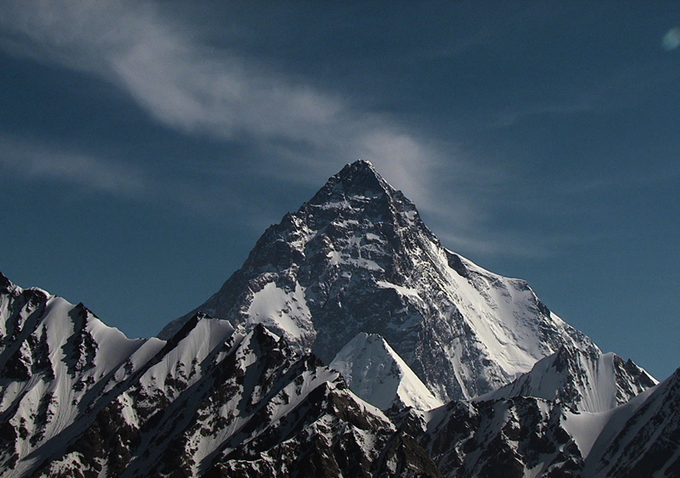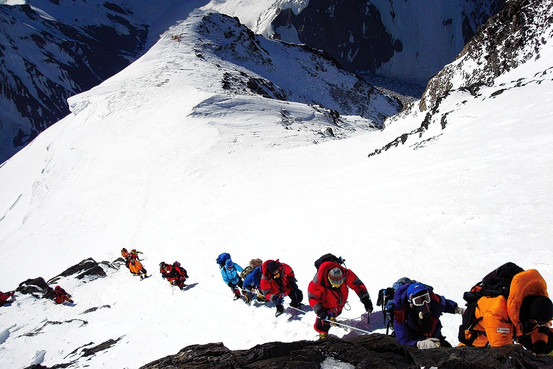Near the climax of “The Summit,” climber Cecilie Skog compares the dangers of extreme mountain climbing to driving. We see car crashes all the time, but we continue to drive thinking, “It won’t happen to me.”
The difference is that most fated drivers don’t go looking for the crash.

It is estimated that K2, also known as the Savage Mountain, takes the life of one in every four climbers that attempt to reach its peak.

The 2008 team attempts to climb through a particularly deadly gully called “the bottleneck” with fixed ropes that are later destroyed by falling ice.
Climbers do.
Irish independent documentary “The Summit” recounts the tragic 2008 expedition to the summit of K2 that led 11 climbers to their deaths. K2, located on the border between Pakistan and China, is called the “Savage Mountain” because of its high mortality rate—one in every four climbers who try to reach the top dies.
Through interviews, archival footage and cinematic re-enactments, “The Summit” tells the story of 10 international teams that together attempted to summit the treacherous mountain to disastrous results. During the group’s nighttime descent, an ice avalanche took out the team’s fixed ropes and the climbers who were not killed in the first icefall found themselves stranded in the “death zone.”
Like many doomed adventure stories—“Into the Wild” and “127 Hours” come to mind—the primary question asked in “The Summit” is one concerned with the selfish nature of recklessness and the existential allure of thrill seeking.
For the 2008 K2 climbers, the drive to experience, revel in and physically defeat one of the world’s most threatening natural wonders was literally worth dying for. The film, and the tragedy itself, examines the thin line between living fully and dying preemptively—it explores the moment when a desire to feel “alive” is reduced to an ironic death wish.
It’s often hard to sympathize with people who bring pain upon themselves—that “I told you so” instinct always kicks in whether we want it to or not. That’s precisely what makes “The Summit” so stressful, heartbreaking and difficult to watch without shaking your head in amazement or, more often, disapproval. The disaster is inherently steeped in irresponsibility and the endeavor rolls sharply downhill immediately—the teams leave their camp 75 minutes late, meaning their time to summit in daylight is limited, and do not have a guide to lead the climb. As if those weren’t warning signs enough, one mountaineer dies at the very beginning of the ascent, before they even reach the death zone, and yet they push on. The climbers were so blinded by their goal to summit the monster that they actively dismissed their own safety and the well-being of loved ones they would ultimately leave behind.
In the shadow of death, the team’s moral lines blur as their bodies begin to fail them. The press coverage highlighted in the film implies that there can be no true heroes in such a dire and subjective situation—one deceased climber is considered “stupid” because he stalled his descent to help fellow mountaineers, while another is “selfish” because he chose to pass them by in order to survive.
The film feebly attempts to explore this moral dilemma by incorporating re-enacted footage of the first successful, and controversial, summit of K2 in 1954. Strange, staged interviews with an actor posing as climber Walter Bonatti recount the 1954 climb that briefly rendered him a villain at the expedition’s end. Regardless of the filmmakers’ intent, the Bonatti scenes of “The Summit” were not only awkward, but debatably unethical—the film fails to clearly indicate that the interviewee is not actually Bonatti, but a paid actor. We don’t realize this until the very end of the film when it is revealed that he died in 2011.
At its core, “The Summit” is a powerful, but disturbing film and the ambiguity of its messages make the documentary an exhausting one to watch. For many viewers, it will be difficult to sympathize with the people on-screen because they choose to ignore their own mortality and flagrantly disregard the potential consequences of a dangerous pastime.
But, for others, the film will tell a more beautiful tale. The story of “The Summit” is not necessarily one of tragedy, but of human passion, and what that passion can accomplish even in the face of death.












Andy
Mar 5, 2016 at 7:35 pm
While many points you make are true, I don’t think this review does any justice at all to the Sherpas and Pakistani guides that were killed, just for doing their jobs. At one point in the film one says something like ‘they thought that because they had hired us they owned our lives.’